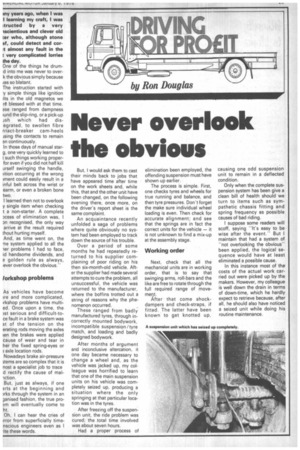Never overlook the obvious
Page 31

If you've noticed an error in this article please click here to report it so we can fix it.
But, I would ask them to cast their minds back to jobs that have appeared time after time on the work sheets and, while this, that and the other unit have been changed, on the following evening there, once more, on the driver's report sheet is the same complaint.
An acquaintance recently unfolded a saga of problems where quite obviously no system had been employed to track down the source of his trouble.
Over a period of some months he had repeatedly re turned to his supplier com plaining of poor riding on his then six-month-old vehicle. Aft er the supplier had made several attempts to cure the problem, all unsuccessful, the vehicle was returned to the manufacturer, where the boffins trotted out a string of reasons why the phenomenon occurred.
These ranged from badly manufactured tyres, through in correctly mounted bodywork, incompatible suspension /tyre match, and loading and badly designed bodywork.
After months of argument and inconclusive altercation, it one day became necessary to change a wheel and, as the vehicle was jacked up, my colleague was horrified to learn that one of the main suspension units on his vehicle was completely seized up, producing a situation where the only springing at that particular location was in the tyres.
After freezing off the suspension unit, the ride problem was cured; the total time involved was about seven hours.
Had a proper process of elimination been employed, the offending suspension must have shown up earlier.
The process is simple. First, one checks tyres and wheels for true running and balance, and then tyre pressures. Don't forget the make sure individual wheel loading is even. Then check for accurate alignment; and see that the springs are in fact the correct units for the vehicle — it is not unknown to find a mix-up at the assembly stage.
Working order
Next, check that all the mechanical units are in working order, that is to say that swinging arms, roll-bars and the like are free to rotate through the full required range of movement.
After that come shockdampers and check-straps, if fitted. The latter have been known to get knotted up, causing one odd suspension unit to remain in a deflected condition.
Only when the complete suspension system has been give a clean bill of health should we turn to items such as sympathetic chassis fitting and spring frequency as possible causes of bad riding.
I suppose some readers will scoff, saying "It's easy to be wise after the event.But I maintain that had a system of "not overlooking the obviousbeen applied, the logical sequence would have at least eliminated a possible cause.
In this instance most of the costs of the actual work carried out were picked up by the makers. However, my colleague is well down the drain in terms of down-time, which he hardly expect to retrieve because, after all, he should also have noticed a seized unit while doing his routine maintenance.




















































































